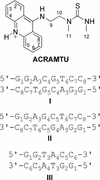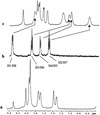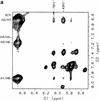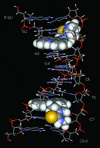Unusual intercalation of acridin-9-ylthiourea into the 5'-GA/TC DNA base step from the minor groove: implications for the covalent DNA adduct profile of a novel platinum-intercalator conjugate
- PMID: 12853631
- PMCID: PMC165979
- DOI: 10.1093/nar/gkg465
Unusual intercalation of acridin-9-ylthiourea into the 5'-GA/TC DNA base step from the minor groove: implications for the covalent DNA adduct profile of a novel platinum-intercalator conjugate
Abstract
The binding of the novel cytotoxic acridine derivative, 1-[2-(acridin-9-ylamino)ethyl]-1,3-dimethylthiourea (ACRAMTU) to various self-complementary oligonucleotide duplexes has been studied by combined high-resolution NMR spectroscopy/restrained molecular dynamics and equilibrium binding assays to establish the sequence and groove specificity of intercalation. The binding mode in the sequences d(GGACGTCC)(2) and d(GGAGCTCC)(2) was deduced from chemical shift changes and intermolecular NOEs between the ligand and the oligonucleotides. ACRAMTU intercalated into the 5'-CG/CG and 5'-GA/TC base steps, and penetration of the duplexes occurred from the minor groove. Intercalation of ACRAMTU in d(GGTACC)(2) occurs at the central TA/TA step, based on the absence of the internucleotide A4H8-T3H1' and A4H8-T3H3' cross-peaks in the 1:1 complex of this sequence. An energy- minimized AMBER model of the 1:2 complex, [d(GGAGCTCC)(2)(ACRAMTU)(2)], was generated, which was based on restricted molecular dynamics/ mechanics calculations using 108 NOE distance restraints (including 11 DNA-drug distances per ligand). Equilibrium dialysis experiments were performed using octamers containing various base steps present in the 'NMR sequences'. The highest affinity for ACRAMTU was observed in d(TATAT ATA)(2), followed by d(CGCGCGCG)(2) and d(GAG ATCTC)(2). The binding levels for CG/CG and GA/TC were virtually the same. The unusual tolerance of the GA/TC intercalation site and the pronounced groove specificity of ACRAMTU play a significant role in the molecular recognition between the corresponding platinum conjugate, Pt-ACRAMTU, and DNA.
Figures










References
-
- Denny W.A. (2002) Acridine derivatives as chemotherapeutic agents. Curr. Med. Chem., 9, 1655–1665. - PubMed
-
- Baguley B.C. (1991) DNA intercalating antitumor agents. Anti-Cancer Drug Des., 6, 1–35. - PubMed
-
- Topcu Z. (2001) DNA topoisomerases as targets for anticancer drugs. J. Clin. Pharm. Ther., 26, 405–416. - PubMed
-
- Geminéz-Arnau E., Missailidis,S. and Stevens,M.F.G. (1998) Antitumour polycyclic acridines. Part 4. Physico-chemical studies on the interactions between DNA and novel tetracyclic acridine derivatives. Anti-Cancer Drug Des., 13, 431–451. - PubMed
-
- McCrystal M.R., Evans,B.D., Harvey,V.J., Thompson,P.I., Porter,D.J. and Baguley,B.C. (1999) Phase I study of the cytotoxic agent N-[2-(dimethylamino)ethyl]acridine-4-carboxamide. Cancer Chemother. Pharmacol., 44, 39–44. - PubMed
Publication types
MeSH terms
Substances
LinkOut - more resources
Full Text Sources
Other Literature Sources
Research Materials

